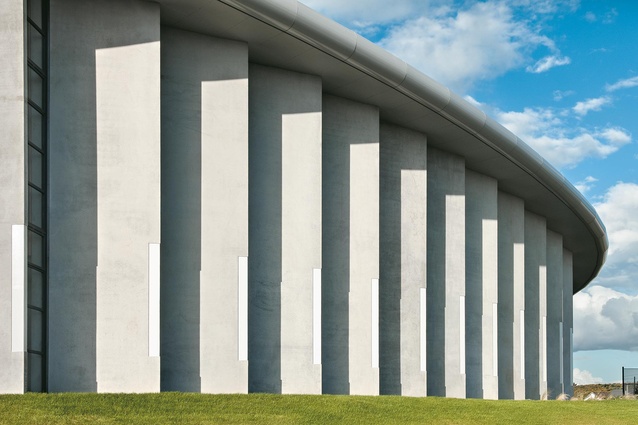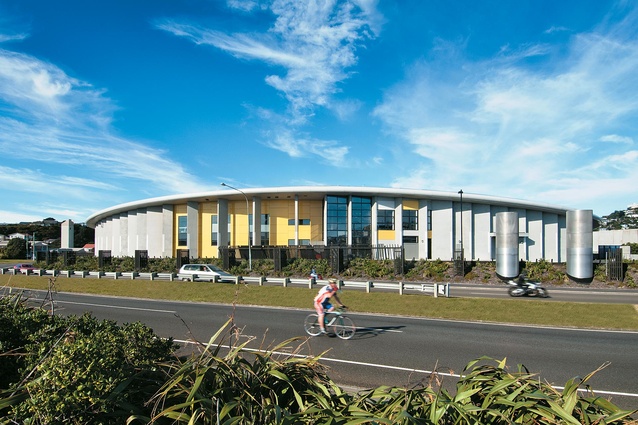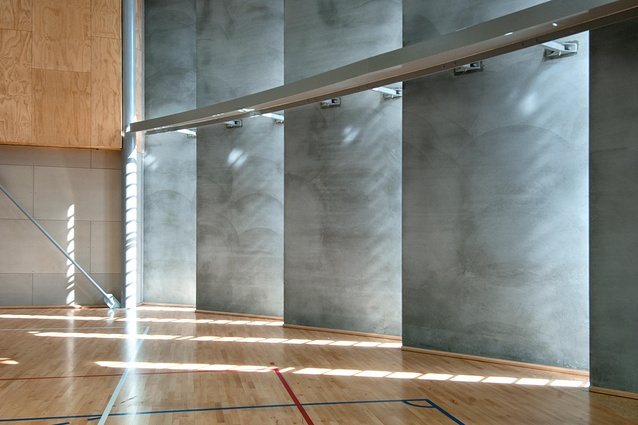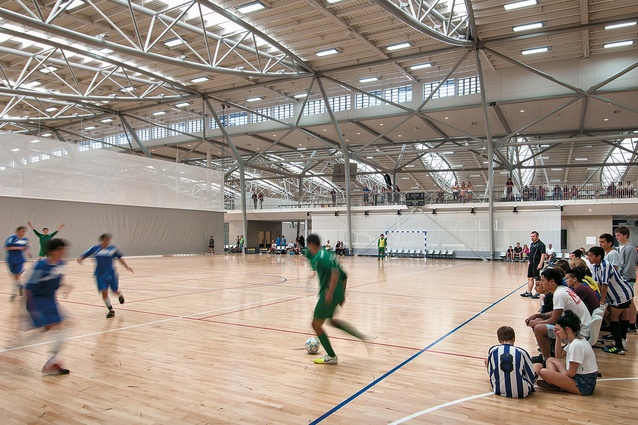ASB Sports Centre
Wellington’s ASB Sports Centre is a creeper; sitting into Evans Bay, it is hunkered in between the ocean and the neighbouring hills and most people will have viewed its undulating elliptical form while whizzing past on the way to or from the airport. It’s been hard to miss since it popped up on the Kilbirnie shore line, built in time for the Wellington-based teams to train for the Rugby World Cup. I have to admit that I’d driven past it a number of times without really understanding what it was and quite how significant it is as a piece of architecture.
That’s not to discredit Tennent + Brown Architects; this sports venue creeps up on you like many of the good things in life. It’s a truly civic building and a very good one at that, rather than one of those schemes where you’re inspired by the pretty magazine pictures and then become disappointed in the flesh; this building is much better explored in real time.
Wellington is probably the best city in New Zealand on a hot and sunny day and I was privileged to visit the Sports Centre on one of those stunners, amidst The Hobbit fever as Hollywood’s great and good arrived for the big red-carpet event. The Centre was abuzz with secondary-school students from across the land, in the midst of a raucous volleyball tournament. Balls were flying about, whistles were bleating, teenagers were lounging around the place – on the front steps of the entrance, in the side rooms and café, across the bleachers – regaining their depleted energy levels. The air was alive with a mild whiff of hormonal sweat. It was exactly as the architects had dreamed it would be, I’m certain.
You see, the history of this project, like so many of our civic schemes, was fraught with typical drama. Tennent + Brown began the project in partnership with Sinclair Knight Merz (SKM), who’d worked on Stadium Australia, and their design was the result of a competition held at the end of 2006. However, a city councillor and other locals appealed the scheme, so the mayor stepped in and suggested mediation to avert their objections being taken to the Environmental Court, delaying the programme. On the surface, their objections might have seemed justified: the obvious solution would have been to site this much-needed indoor sports centre along the other end of the city, near to its cousin, the Westpac Stadium, whose close proximity to the train station, bus interchange and motorway provides easy access from different parts of the city.
The idea of siting this sports hub on the other side of the Mount Vic tunnel, already a bottleneck in Wellington’s infrastructure, seemed ridiculous to some. However, what the opposers failed to properly grasp, and fortunately Sir John Anderson’s review of the case understood, was that this sports facility is intended mainly to be a community destination, set within a 5km radius of around 40 schools and catering for hundreds of visitors to a couple of thousand, rather than the tens of thousands that might be expected at a larger stadium venue built for rugby matches and the like.
Tennent + Brown took over the design when SKM closed its architectural arm at about the Resource Consent phase, giving the practice a unique opportunity to produce this large civic structure. It then brought in a sports planner from Melbourne, Sean Stone, to assist in dealing with the complexities of this type of sporting venue.
Opened to the wider public in early 2012, the centre can seat up to 2,222 spectators, primarily catering to a rolling schedule of schools and sports clubs, along with specialist and high-performance sports training and so on. The main codes for three core sports – basketball, volleyball and, particularly, netball – determine the scheme’s geometry, although it accommodates around 10 different sports, such as handball, futsal, roller skating and frisbee. Wellington City Council’s ambition for the scheme wasn’t about stadium sports but chiefly to improve the physical well-being of the public by involving young people, providing them with first-class facilities from the offset.
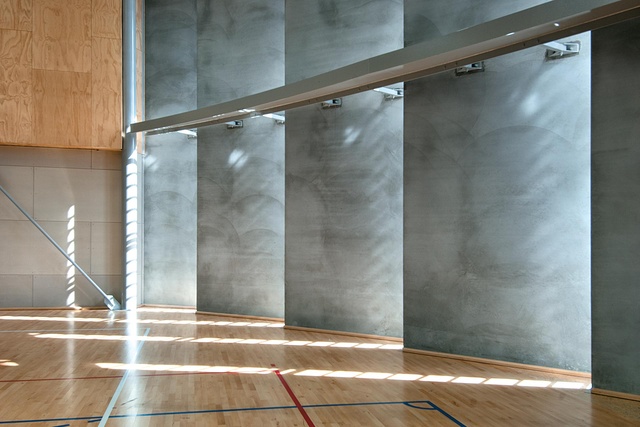
The classic timber sports floor is sprung to Olympic standards and there is 9,245m2 of it. Two sports chambers, each about the size of a rugby field, are separated by an elevated spine that forms a central walkway across the middle of the building and a viewing platform onto the courts as well. Orientated from north to south, the spine tapers out towards its southern end – as footfall peels off and down three staircases onto the courts – and leads on to a small observation point over the harbour, along with meeting rooms and other facilities.
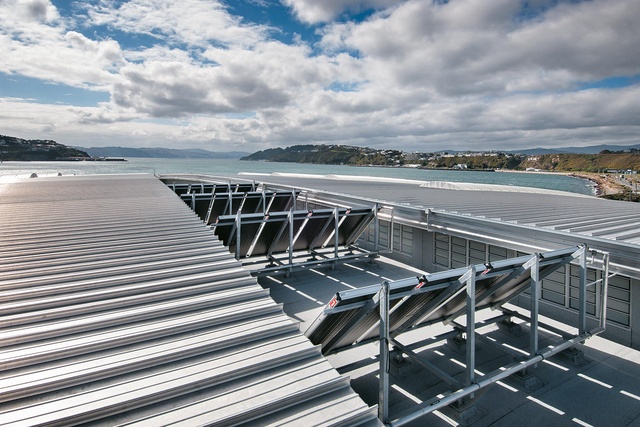
The building’s curvaceous steel roof structure is anthropomorphic in form and very dynamic as it appears to move in many directions with its bow trusses acting like ribs off the central spine. Triple-glazed skylights sit in behind, sending a surprisingly-soft natural light down and all around the space, aided by the off-white-coloured ceiling and steelwork.
The concept for the building is a simple and compelling idea – a large maritime form, partly inspired by the local mussel shell and clearly identifiable as a public building – but one of the reasons it is so successful is that it works like a tardis. It’s the biggest structure within its urban setting but contextually it still sits lightly; externally, it doesn’t seem that big but inside the space is enormous and is quite a revelation. Architect Hugh Tennent suggests that, “Because the structure is curved, it’s really hard for the eye to determine just how big this building is because there aren’t any corners. When you’re outside, it’s always receding away from you in terms of the roof.” The swooping roof line is higher at the ends to symbolise the entrance on one side and the seafront on the other. Ewan Brown adds, “Even though the roof undulates around the building, it’s not very high, only 10m at the perimeter, although in the middle it’s 15m; so, on the outside, you only ever see the eave at 10m – it disappears, whereas, if you had 15m at the edge, the building would seem much larger”.
This kind of sports building typology is typically designed as a large, contained, air-conditioned box and the ASB Sports Centre could easily have gone down that route; however, the client and the architects were keen to pursue the curved form and a sustainable response. Working on the ESD strategy with eCubed Building Workshop, they created a naturally lit and ventilated, and highly insulated, solution with minimal energy cost requirements. Huge monumental louvres, which sit between precast concrete panels, draw air into the building and out through the roof. The louvres also help to shield the internal environment, being angled against Wellington’s harshest winds. It is not hard to imagine that this can be an extremely aggressive site; the wind load is 5.4kba only 10m off the ground which, combined with salty driving rain, also raised serious concerns about corrosion, both inside and out. So, the structure and materiality were treated accordingly with numerous preventative measures.
Around the sports centre, the staggered walls lend transparency to the structure; passers-by can see life within the building and the occupants inside can also enjoy the external views, adding to the scheme’s general sense of community. These strong monumental-scale verticals also help to unify the design, giving it oneness. In fact, there are very few urban civic buildings in New Zealand that you can view from a land-based position on all sides and from above; we should be very grateful that this design is one of them.

